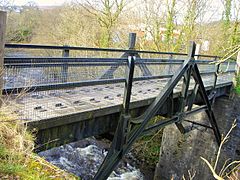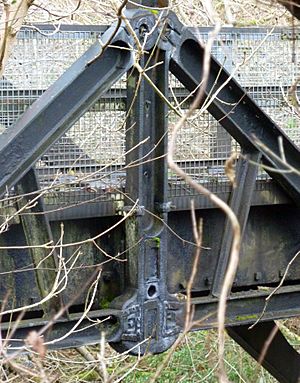Pont-y-Cafnau facts for kids
Quick facts for kids Pont-y-Cafnau |
|
|---|---|

Pont-y-Cafnau
|
|
| Coordinates | 51°45′17″N 3°23′44″W / 51.75467°N 3.39550°W |
| Carries | (originally) Gurnos Tramway, aqueduct; (today) pedestrians |
| Crosses | River Taff |
| Locale | Cyfarthfa Ironworks, Merthyr Tydfil |
| Other name(s) | Bridge of Troughs |
| Characteristics | |
| Design | King post truss |
| Material | Cast iron |
| Total length | 14.2 metres (47 ft) |
| History | |
| Designer | Watkin George |
| Constructed by | Cyfarthfa Ironworks |
| Construction end | January–June, 1793 |
The Pont-y-Cafnau is a very old and important bridge in Merthyr Tydfil, Wales. Its name means Bridge of Troughs in English. This bridge is special because it's the world's oldest surviving iron railway bridge. It was built in 1793 and is made of cast iron.
The Pont-y-Cafnau is a type of bridge called a truss bridge. A truss bridge uses a framework of triangles to make it strong. It crosses the River Taff. When it was first built, it carried two things: a tramway (a track for small wagons) and an aqueduct (a structure that carries water). These were used to bring limestone and water to the nearby Cyfarthfa Ironworks. Today, the bridge is a listed building and a Scheduled monument, and people can walk across it.
Contents
The Story of Pont-y-Cafnau
Why Was the Bridge Needed?
The Cyfarthfa Ironworks started in 1765 and became one of the biggest iron-making factories in the world. To make iron, they needed a lot of limestone. This limestone came from the Gurnos Quarry.
To get the limestone to the ironworks, a special tramway was built between 1792 and 1793. The Pont-y-Cafnau bridge was a key part of this tramway. It helped carry the limestone wagons over the River Taff.
How Water Crossed the River
The ironworks also needed a lot of water for power. Water was taken from two rivers, the Taff Fawr and the Taff Fechan, using channels called leats.
One of these water channels, from the Taff Fawr, was carried in an elevated (raised) aqueduct made of cast iron. This aqueduct crossed the Taff Fechan and then the main River Taff at the Pont-y-Cafnau bridge. The water then powered a huge water wheel at the ironworks.
Another water channel, from the Taff Fechan, was at ground level. It also crossed the Taff at Pont-y-Cafnau. This water went to the brick works nearby. So, the bridge had three levels: one for the raised water channel, one for the tramway, and one for the ground-level water channel.
Building the Bridge
The Pont-y-Cafnau bridge was built between January and June 1793. It replaced an older bridge made of wood. This new iron bridge became the world's oldest known iron railway bridge. By 1850, the highest water channel was removed, as a new one was built on the other side of the river.
Who Designed the Bridge?
The bridge was designed by a man named Watkin George. He was originally trained as a carpenter, someone who works with wood. But in 1792, he became the chief engineer at the Cyfarthfa Ironworks and a partner in the business.
How the Bridge Was Built
The Pont-y-Cafnau bridge is made of two large cast iron A-frame trusses. These trusses support a rectangular iron trough below them. This lower trough carried the water from the Taff Fechan. It also acted as a strong girder to hold the railway tracks.
Interestingly, because Watkin George was a carpenter, the parts of the bridge are joined together using methods usually found in wooden structures. These include dovetail and mortise and tenon joints. This shows how early iron bridges sometimes used techniques from other building trades.
Protecting This Old Bridge
The Pont-y-Cafnau bridge is very important for history. Because of this, it has been given special protection.
On August 22, 1975, it was listed as a Grade II* listed building. This means it's a very important historic building. It is also listed as a Scheduled Ancient Monument. This gives it even more protection.
The local government has fixed up the bridge, and now it is used as a footbridge. This means people can walk across it and enjoy this amazing piece of history.


